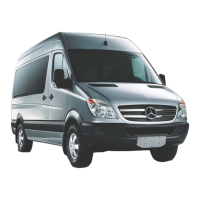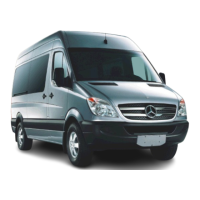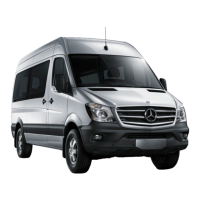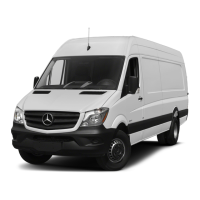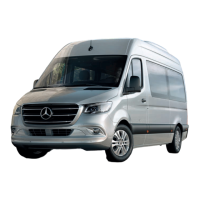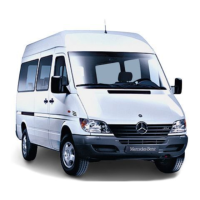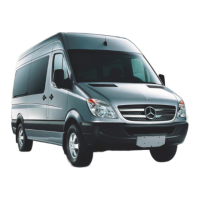Rating.You can find theGross Axle Weight Rating
on theB-pillar on thedriver's side.
Speed rating: thespeed rating is part of thetire
identification.Itspecifies thespeed rangefor
whichatireisapproved.
GVW(Gross VehicleWeight): theGross Vehicle
Weight includes theweight of thevehicle includ‐
ing fuel, tools, thesparewheel, accessories
installed, occupants, luggageand thetrailer
drawbar noseweight if applicable. The Gross Vehi‐
cle Weight mustnever exceed theGross Vehicle
Weight Rating (GVWR)specifiedonthe B-pillar on
thedriver's side.
GVWR (Gross VehicleWeight Rating): the
GVWR is themaximum permitted gross weight of
thefully laden vehicle (weight of thevehicle
including all accessories, occupants, fuel, lug‐
gage and thetrailer drawbar noseweight if appli‐
cable). The Gross Vehicle Weight Rating is speci‐
fied on thevehicle identification plateonthe B-
pillar on thedriver's side.
Maximum weight of theladen vehicle: the
maximumweight is thesum of thevehicle's curb
weight,weight of theaccessories, maximum load
and theweight of thefactoryinstalled optional
equipment.
Kilopascal (kPa): metric unit fortirepressure.
6.9 kPaare theequivalent of 1psi. Another unit
fortirepressure is bar.100 kilopascals (kPa) are
theequivalent of 1bar.
Load index: in addition to theload-bearing index,
theload indexmay also be imprinted on theside‐
wall of thetire. This specifies theload-bearing
capacity moreprecisely.
Curbweight: theweight of avehicle withstand‐
ardequipmentincludingthe maximum capacity
of fuel, oil and coolant. It also includes theair-
conditioning system and optional equipment if
these areinstalled on thevehicle, but does not
include passengersorluggage.
Maximum tireload: themaximum tireload is
themaximum permissible weight in kilograms or
lbs forwhichatireisapproved.
Maximum permissible tirepressure: maximum
permissible tirepressurefor one tire.
Maximum load on one tire: maximum load on
one tire. This is calculated by dividing themaxi‐
mum axle load forone axle by two.
PSI (pounds per squareinch): standardunit of
measurementfor tirepressure.
Aspectratio: relationship between tireheight
and tirewidthinpercent.
Tire pressure: pressureinside thetireapplying
an outwardforce to every squareinchofthe
tire's surface. The tirepressureisspecified in
pounds per squareinch(psi), in kilopascal (kPa)
or in bar.The tirepressureshould onlybecorrec‐
tedwhen thetires arecold.
Tire pressureoncoldtires: thetires arecold
when thevehicle has been parkedwiththe tires
out of direct sunlight foratleast threehoursand
thevehicle has been driven less than 1mile
(1.6 km).
Tire contact surface: thepartofthe tirethat
comes intocontact with theroad.
Tire bead: thepurpose of thetirebead is to
ensurethat thetiresits securely on thewheel
rim. Thereare severalwirecores in thetirebead
to prevent thetirefromchanging lengthonthe
wheelrim.
Sidewall: thepartofthe tirebetween thetread
and thetirebead.
Special equipment weight: thecombined
weight of those optional extras that weigh more
than thereplaced standardparts and morethan
5lbs (2.3kg). These optionalextras,suchas
high-performance brakes, levelcontrol system, a
roof luggagerackorahigh-performancebattery,
arenot included in thecurb weight and the
weight of theaccessories.
TIN (TireIdentification Number): auniqueiden‐
tification number whichcan be used by atire
manufacturer to identify tires, forexample fora
product recall, and thus identifythe purchasers.
The TIN is made up of themanufacturer identifi‐
cation code, tiresize, tiretype code and theman‐
ufacturing date.
Load-bearing index: theload-bearing index(also
load index) is acode that contains themaximum
load-bearing capacity of atire.
Traction: traction is theresult of friction between
thetires and theroad surface.
Wear indicator: narrow bars(tread wear bars)
that aredistributed overthe tiretread. If thetire
tread is levelwiththe bars, thewear limit of
1/16in(1.6mm) has been reached.
Distribution of vehicleoccupants: distribution
of vehicle occupants over designated seat posi‐
tions in avehicle.
Wheels and tires
309

